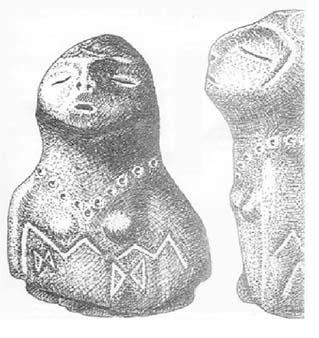|
|
|
|
The Cassiopea
mark and the butterfly double-symbology is found in a "terracotta"
figurine (cm 6,5 x 2) recovered in Passo di Corvo (Foggia, Daunia,
South-Italy) the greatest village of European Neolithic period
(Tiné S., 1983). |
|
The Tiné suspects that other parts have been coloured, but he doesn't produce the consequent hypothesis, and the most coherent in this contest, that the red pits were the blood that came down from the shamanic woman's nose while in a trance-like condition (Solomon A., 1997). |
|
An ulterior
confirmation to this hypothesis can be deduced by the Cavillon
Grotto's Tomb excavations, near Grimaldi (Imperia - Ligurian
Riviera) where a statuette has been recovered which is characterized
by an ochre filled furrow (cm 18 long) that departed from
the nose till the mouth (Leroi-Gourhan A.,1970). |
